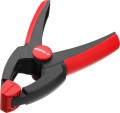Clamping width provided by vise or clamp (see "Type")
In this case, the width of the clamp means the maximum distance that the jaws or stops of the tool can be spread, in other words, the maximum size of an object that can be clamped with this device.
Large clamping width, on the one hand, makes the tool more versatile and expands its capabilities; on the other hand, it affects the dimensions, weight and price, and also makes it difficult to work with small objects (a large tool is poorly suited for this). So, when choosing according to this parameter, you should not chase after the maximum margin, but take into account the size of the parts that you really plan to work with: for example, it hardly makes sense to buy a 500 mm clamp if you need a clamp for gluing plywood planks together.
The depth of clamping provided by a vise or clamp (see "Type").
This parameter specifies how deep the clamped part can go between the jaws or stops until its edge rests against the tool. When choosing according to the depth of the clamp, note that a large depth accordingly affects the dimensions, weight and price of the tool.

